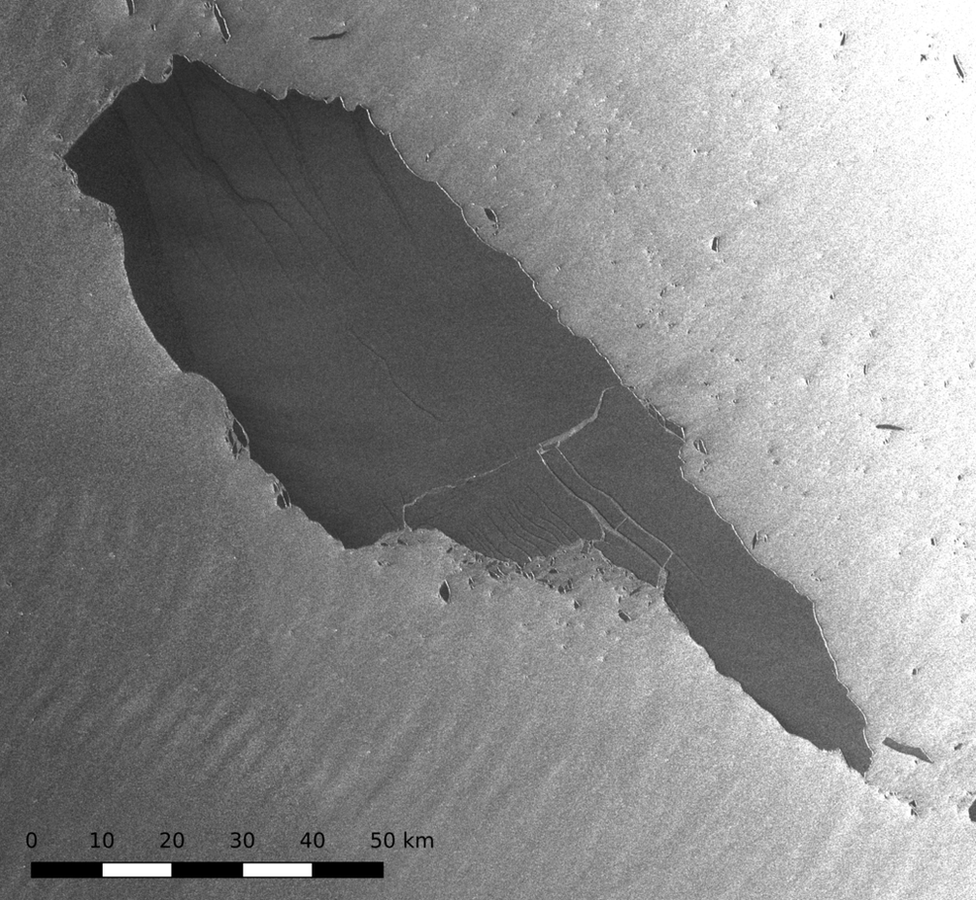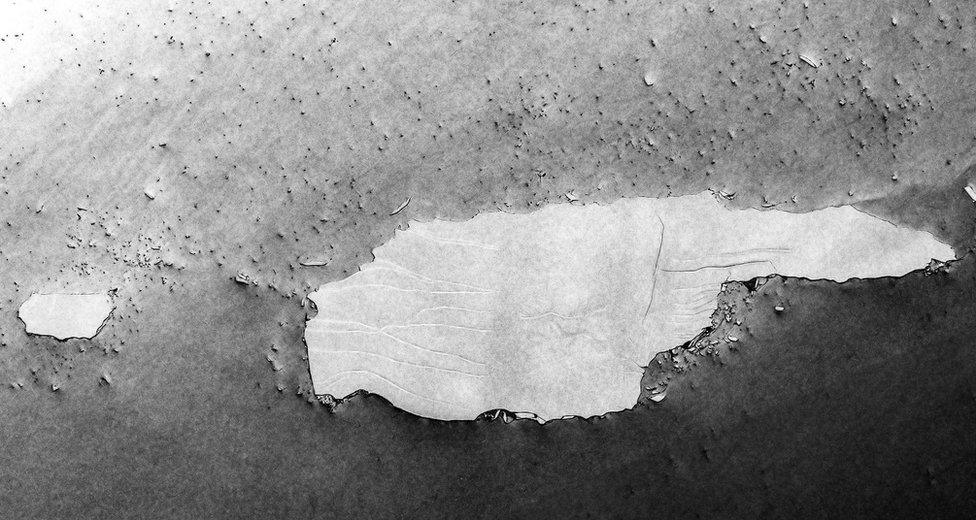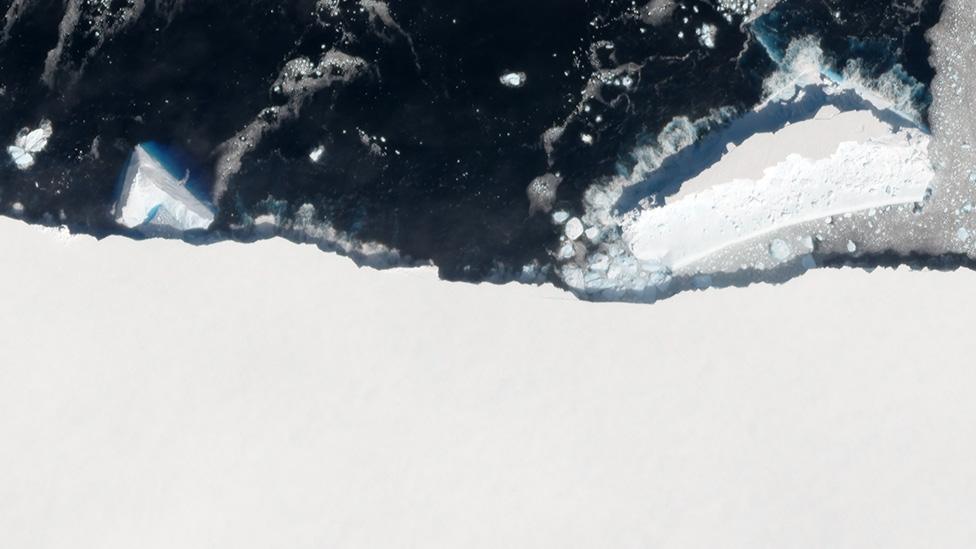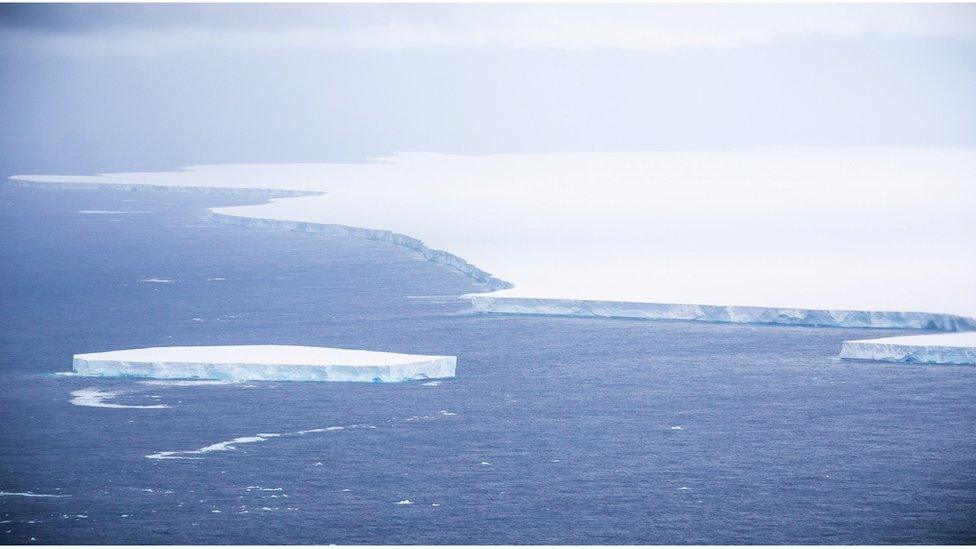Giant iceberg A68a shatters into large fragments
- Published

A68a: The section that looks like a "finger" has snapped
The giant iceberg that's been drifting through the South Atlantic looks to have experienced a major break-up.
Tuesday's latest satellite imagery reveals major fissures in the tabular berg known as A68a, with huge blocks of ice starting to separate and move away from each other.
A68a, which calved from Antarctica in 2017, has been floating off the coast of South Georgia island.
Experts have been watching to see if it might ground in shallow water.
Were that to happen - and parts of the berg still could - it might cause problems for the British Overseas Territory's penguins and seals as they go about foraging for fish and krill.
The image at the top of this page comes from the EU's Sentinel-1 radar spacecraft. It was acquired at 07:17 GMT on Tuesday.
Although cracks were very pronounced on Monday, they hadn't by that stage cut right through A68a.
"Nearly three-and-a-half years since it calved away from Larsen C Ice Shelf, Iceberg A68a - the fourth largest on record - is finally beginning to disintegrate," observed Adrian Luckman from Swansea University, UK.
Allow X content?
This article contains content provided by X. We ask for your permission before anything is loaded, as they may be using cookies and other technologies. You may want to read X’s cookie policy, external and privacy policy, external before accepting. To view this content choose ‘accept and continue’.
"As well as being one of the largest icebergs ever recorded, A68 must also be one of the most watched.
"With such a massive recent growth in the volume of satellite data and a huge improvement in the speed at which it can be made available, this capability has been put to good use in monitoring this huge iceberg on its journey from birth to destruction," he told BBC News.
The US National Ice Center operates the naming system for icebergs.

How the berg looked on Monday. Deep cracks but not yet fully fragmented
The bergs get given a prefix letter depending on which quadrant of the Antarctic they calve from, plus a number to designate their position in the sequence of big breakaways. Fragmentations then earn a suffix letter.
Just last week, a big piece broke from A68a and this was called A68d. You can see "d" trailing behind the main berg in another Sentinel-1 image from Monday processed by Pierre Markuse, external.
Two of the largest fragments identified by Sentinel-1 on Tuesday have already been named A68e and A68f.

Allow X content?
This article contains content provided by X. We ask for your permission before anything is loaded, as they may be using cookies and other technologies. You may want to read X’s cookie policy, external and privacy policy, external before accepting. To view this content choose ‘accept and continue’.
GIS and mapping specialist at the British Antarctic Survey Laura Gerrish calculates the areas of the various fragments to be roughly:
A68a - 2,600 sq km
A68d - 144 sq km
A68e - 655 sq km
A68f - 225 sq km
(Fragments A68b and A68c broke away a long time ago and are not in the immediate vicinity)

Laura Gerrish is tracking the berg around South Georgia

Although now much reduced in size, A68a is still imposing and could yet present a sizeable obstacle to South Georgia's foraging marine predators.
At the moment, all the berg fragments are entrained in a fast-moving stream of water known as the Southern Antarctic Circumpolar Current Front. This is likely to sweep the chunks around the island and then throw them north.
Satellites will monitor their progress as they skirt the shallow continental shelf. There are a number of places where the fragments could get caught and anchor in place.
When A68 first calved from Antarctica, it measured almost 6,000 sq km - about a quarter of the size of the Wales.
To put Tuesday's remnant A68a in some context - 2,600 sq km still bigger than Greater London, which covers about 1,500 sq km of land.
Watch: The RAF flies over iceberg A68a

Why A68a has little to do with climate change
The iceberg came from a part of the Antarctic where it is still very cold - the Larsen C Ice Shelf. This is a mass of floating ice formed by glaciers that have flowed down off the eastern side of the Antarctic Peninsula into the ocean. On entering the water, the glaciers' buoyant fronts lift up and join together to make a single protrusion. The calving of bergs at the forward edge of this shelf is a very natural behaviour. The shelf will maintain an equilibrium and the ejection of bergs is one way it balances the accumulation of mass from snowfall and the input of more ice from the feeding glaciers on land. Larsen C calves big icebergs like A68 on decadal timescales.


This very high-resolution image from the Planet company shows A68d's crumbling edge

Originally some 5,800 sq km in size, A68a is now about 2,600 sq km
Jonathan.Amos-INTERNET@bbc.co.uk, external and follow me on Twitter: @BBCAmos, external